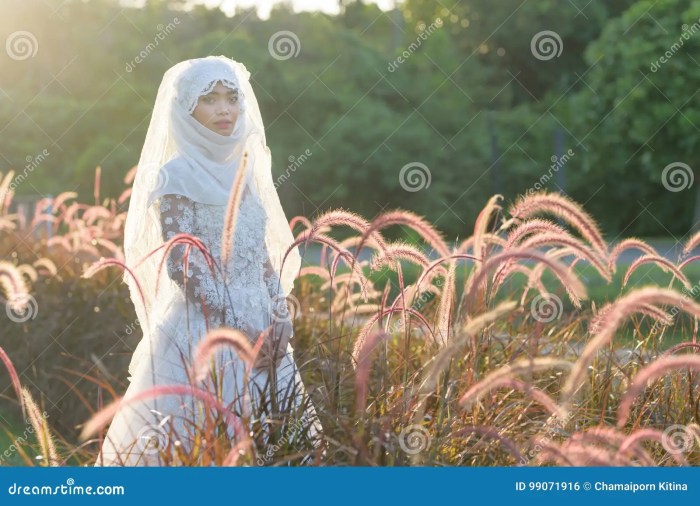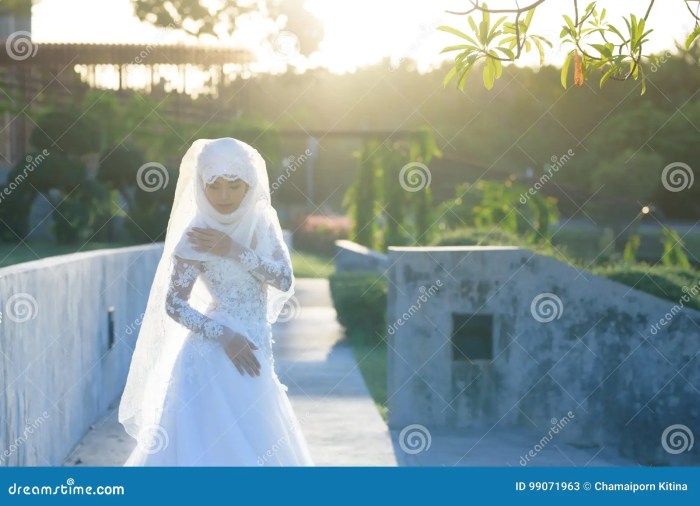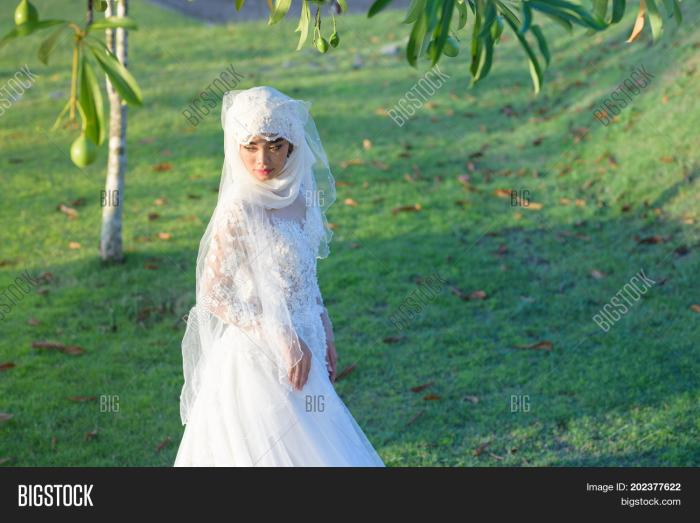The Tradition and Modernity of White Muslim Wedding Dresses: Muslim Wedding Dress White

Source: dreamstime.com
Muslim wedding dress white – The use of white in wedding attire, a relatively recent Western tradition, has seen increasing adoption within Muslim communities globally. This integration, however, is not without its complexities, navigating the intersection of cultural norms, religious interpretations, and evolving fashion trends. This exploration delves into the historical context, contemporary interpretations, and the multifaceted considerations surrounding the choice of white in Muslim bridal wear.
The Tradition of White in Muslim Weddings
Historically, white wasn’t universally associated with bridal attire across Muslim cultures. Traditional wedding garments varied significantly based on regional customs and available resources. While vibrant colors like red, gold, and emerald green were often favored, symbolizing prosperity and joy, the incorporation of white elements was not uncommon, often appearing as accents in embroidery or as part of the overall ensemble.
In contrast to Western weddings, where white signifies purity and virginity, the symbolism of white within Muslim contexts is more nuanced and diverse, reflecting the rich tapestry of Islamic interpretations and cultural practices.
For example, in some parts of the Middle East, off-white or ivory hues were prevalent, often incorporated into intricate embroidered fabrics like silk or brocade. In South Asia, traditional bridal attire often featured elaborate gold embroidery on rich fabrics, with white possibly used as a background color or in subtle detailing. The symbolic meaning of white in Islamic interpretations can range from representing purity and piety to signifying new beginnings and a clean slate.
The significance is often less rigidly defined than in Western traditions, allowing for greater flexibility in its usage within bridal attire.
Examples of traditional Muslim wedding attire incorporating white elements include the Moroccan caftan, often featuring white embroidery on vibrant colored fabric; the Pakistani bridal shalwar kameez, which might include white accents in the embroidery or jewelry; and the Malaysian baju kurung, where white might be used as a base color for delicate embroidery.
Modern Interpretations of White Muslim Wedding Dresses, Muslim wedding dress white
The evolution of white wedding dresses in Muslim communities reflects a growing embrace of Western aesthetics while maintaining adherence to religious and cultural modesty. Contemporary Muslim designers play a crucial role in this evolution, creating innovative designs that blend tradition with modern sensibilities. They carefully navigate the balance between showcasing the beauty of the bride while upholding the principles of modesty central to Islamic faith.
Designers like [Insert Name of a Muslim Designer] and [Insert Name of Another Muslim Designer] are prominent examples, showcasing collections that feature elegant white gowns with modest necklines, long sleeves, and flowing silhouettes. Their work often incorporates traditional embellishments and techniques, adapted to create contemporary interpretations of classic bridal styles.
Below are three conceptual designs illustrating diverse styles of white Muslim wedding dresses:
| Dress Description | Fabric | Embellishments | Silhouette |
|---|---|---|---|
| A minimalist gown with a high neckline, long sleeves, and a flowing A-line skirt. The simplicity of the design allows the beauty of the fabric to take center stage. | Silk crepe | Minimalist beading at the neckline and waist | A-line |
| A traditional-inspired gown with intricate embroidery, long sleeves, and a fitted bodice that flares into a modest A-line skirt. The design incorporates traditional elements while maintaining a modern aesthetic. | Silk brocade | Intricate hand embroidery with gold thread and pearls | Fitted bodice, A-line skirt |
| A modern gown with a sheath silhouette, long sleeves, and a high neckline, featuring subtle embellishments and a clean, contemporary look. The design is sleek and sophisticated, showcasing the beauty of the fabric and the bride’s figure. | Mikado silk | Subtle crystal embellishments at the waist | Sheath |
The Role of Modesty and Cultural Sensitivity

Source: dreamstime.com
Modesty is paramount in Muslim wedding attire. It’s a fundamental principle guiding the design and selection of bridal garments. Designers strive to create stylish white wedding dresses that uphold these values. The interpretation of modesty varies across different Muslim communities, influenced by cultural norms and individual beliefs. Some communities may favor more conservative styles with full coverage, while others may allow for more flexibility in design.
- Long sleeves
- High necklines
- Floor-length skirts
- Layered fabrics for added coverage
- Avoidance of revealing cuts or silhouettes
- Use of opaque fabrics
Accessories and Styling for a White Muslim Wedding Dress

Source: bigstockphoto.com
Appropriate head coverings, such as hijabs and veils, play a crucial role in completing the bridal look. These accessories are chosen to complement the wedding dress and reflect the bride’s personal style and religious beliefs. The choice of hijab or veil can range from simple and elegant to more elaborate and ornate, depending on personal preference and cultural context.
Jewelry and other accessories are carefully selected to enhance the overall aesthetic while respecting cultural and religious sensitivities.
Different fabrics and embellishments can significantly enhance the overall look of a white Muslim wedding dress. Delicate lace, intricate embroidery, or subtle beading can add a touch of elegance and sophistication. The choice of fabric can also impact the overall feel of the dress, with flowing fabrics creating a romantic look, while structured fabrics offer a more contemporary aesthetic.
Hair styling also plays a significant role in the overall appearance of the bride. A simple, elegant updo can complement a minimalist dress, while a more elaborate hairstyle might be appropriate for a more ornate gown. Examples include a classic chignon, a braided updo, or a loose, flowing style that is still modest and respectful.
Challenges and Opportunities for Muslim Bridal Fashion
Muslim brides often face challenges in finding suitable white wedding dresses that align with their religious and cultural beliefs. Limited availability of modest designs in mainstream bridal shops can necessitate seeking out specialized designers or tailoring custom-made garments. However, the growing demand for modest bridal wear presents significant opportunities for growth and innovation within the Muslim bridal fashion industry.
Successful Muslim bridal businesses have emerged, catering to this growing market and showcasing the creativity and talent within the community. Social media and online platforms have become increasingly influential, shaping trends and providing brides with access to a wider range of designers and styles. These platforms offer a space for showcasing diverse designs, inspiring brides, and connecting them with designers who understand and cater to their specific needs and preferences.
Clarifying Questions
What fabrics are most commonly used in modest white Muslim wedding dresses?
Common fabrics include silk, chiffon, crepe, and lace, often chosen for their drape and luxurious feel. Heavier fabrics like brocade might be used for embellishment.
How can I incorporate cultural details into my white Muslim wedding dress?
Yo, check it, Muslim wedding dress white? Properly lush, innit? But don’t sleep on the mother of the groom’s fit, especially for an outdoor do – you need something that’s gonna slay, so peep this link for some serious inspo: mother of the groom dress for outdoor wedding. Back to the bride though, that white dress needs to be next level.
Incorporate cultural details through embroidery, beading, or appliqués that reflect your heritage. Consider regional patterns or motifs for a personalized touch.
Are there specific types of veils or head coverings traditionally worn with a white Muslim wedding dress?
Yes, various styles of hijabs and veils are worn, depending on cultural and personal preferences. These can range from simple, elegant styles to more elaborate, embellished pieces.
Where can I find reputable designers specializing in modest Muslim wedding attire?
Many designers specialize in modest bridal wear; searching online for “modest Muslim wedding dresses” will reveal numerous options. Look for designers who showcase their work and customer testimonials.
